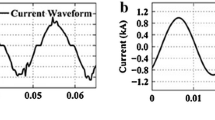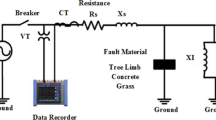Abstract
Despite extensive research, the detection of arcing high-impedance faults (HIFs) in the low and medium voltage transmission and distribution networks remains a formidable challenge. Conventional overcurrent relays fail to detect the high-impedance faults due to their low fault current. However, even the modern digital relays utilizing the advanced signal processing techniques and expert classifiers are not able to solve the issue with conviction because of the random, nonlinear, and asymmetric nature of the arcing current. A lot of research work is carried out to improve the detection accuracy of the HIFs with a higher level of security against non-HIF transient events. This paper proposes a comprehensive review of the traditional as well as modern HIF detection schemes along with their advantages and drawbacks.
Access this chapter
Tax calculation will be finalised at checkout
Purchases are for personal use only
Similar content being viewed by others
References
Aucoin M (1985) Status of high impedance fault detection. IEEE Power Eng Rev PER-5 3:39–40
Kim CJ, Russell BD, Watson K (1990) A parameter-based process for selecting high impedance fault detection techniques using decision making under incomplete knowledge. IEEE Trans Power Delivery 5(3):1314–1320
Sedighi R, Haghifam MR, Malik OP, Ghassemian MH (2005) High impedance fault detection based on wavelet transform and statistical pattern recognition. IEEE Trans Power Delivery 20(4):2414–2421
Macedo JR, Resende JW, Bissochi CA, Carvalho D, Castro FC (2015) Proposition of an interharmonic-based methodology for high-impedance fault detection in distribution systems. IET Gener Trans Distrib 9(16):2593–2601
Theron JCJ, Pal A, Varghese A (2018) Tutorial on high impedance fault detection. In: 2018 71st annual conference for protective relay engineers (CPRE). College Station, TX, pp 1–23
Kar S, Samantaray SR, Zadeh MD (2017) Data-mining model based intelligent differential microgrid protection scheme. IEEE Syst J 11(2):1161–1169
Gautam S, Brahma SM (2013) Detection of high impedance fault in power distribution systems using mathematical morphology. IEEE Trans Power Syst 28(2):1226–1234
Sedighizadeh M, Rezazadeh A, Elkalashy NI (2010) Approaches in high impedance fault detection—a chronological review. Adv Electri Comput Eng 10(3):114–128
Ghaderi A, Ginn III HL, Mohammadpour HA (2017) High impedance fault detection: a review. Electric Power Syst Res 143:376–388
Mishra M, Panigrahi RR (2019) Taxonomy of high impedance fault detection algorithm. Measurement, 148:106955
Aucoin M, Russell BD, Benner CL (1989) High impedance fault detection for industrial power systems. In: Conference record of the IEEE industry applications society annual meeting, vol 2. San Diego, CA, USA, pp 1788–1792
Emanuel E, Cyganski D, Orr JA, Shiller S, Gulachenski EM (1990) High impedance fault arcing on sandy soil in 15 kV distribution feeders: contributions to the evaluation of the low frequency spectrum. IEEE Trans Power Delivery 5(2):676–686
Wai DCT, Yibin X (1998) A novel technique for high impedance fault identification. IEEE Trans Power Delivery 13(3):738–744
Aucoin M, Russell BD (1982) Distribution high impedance fault detection utilizing high frequency current components. IEEE Trans Power Apparatus and Syst PAS-101 6:1596–1606
Lazkano JR, Leturiondo LA, Aramendi E (2000) High impedance arcing fault detector for three-wire power distribution networks. In: 2000 10th mediterranean electrotechnical conference. information technology and electrotechnology for the mediterranean countries. proceedings. MeleCon 2000 (Cat. No.00CH37099), vol. 3. Lemesos, Cyprus, pp 899–902
Yu C, Khan SH (1994) An adaptive high and low impedance fault detection method. IEEE Trans Power Delivery 9(4):1812–1821
Christie RD, Zadehgol H, Habib MM (1993) High impedance fault detection in low voltage networks. IEEE Trans Power Delivery 8(4):1829–1836
Sultan F, Swift GW, Fedirchuk DJ (1994) Detecting arcing downed-wires using fault current flicker and half-cycle asymmetry. IEEE Trans Power Delivery 9(1):461–470
Kim CJ, Russell BD (1995) Analysis of distribution disturbances and arcing faults using the crest factor. Electr Power Syst Res 35(2):141–148
Soheili Adel, Sadeh Javad, Bakhshi Reza (2018) Modified FFT based high impedance fault detection technique considering distribution non-linear loads: simulation and experimental data analysis. Int J Electr Power Energy Syst 94:124–140
Bakar AHA, Ali MS, Tan CK, Mokhlis H, Arof H, Illias HA (2014) High impedance fault location in 11 kV underground distribution systems using wavelet transforms. Int J Electri Power Energy Syst 55:723–730
Costa FB, Souza BA, Brito NSD, Silva JACB, Santos WC (2015) Real-time detection of transients induced by high-impedance faults based on the boundary wavelet transform. IEEE Trans Ind Appl 51(6):5312–5323
Chen J, Phung T, Blackburn T, Ambikairajah E, Zhang D (2016) Detection of high impedance faults using current transformers for sensing and identification based on features extracted using wavelet transform. IET Gener Trans Distrib 10(12):2990–2998
Santos WC, Lopes FV, Brito NSD, Souza BA (2017) High-impedance fault identification on distribution networks. IEEE Trans Power Delivery 32(1):23–32
Ali MS, AB HALIM AB, Tan CK, Mokhlis H, Arof H (2016) Studies on the application of wavelet families for a high impedance fault location algorithm in a distribution network. Turkish J Electric Eng Comput Sci 24(6):5043–5054
Mahari A, Seyedi H (2015) High impedance fault protection in transmission lines using a WPT-based algorithm. Int J Electr Power Energy Syst 67:537–545
Lima EM, Brito NSD, de Souza BA (2019) High impedance fault detection based on Stockwell transform and third harmonic current phase angle. Electric Power Syst Res 175:105931
Panigrahi RR, Mishra M, Rajan A, Mohapatra S (2018) High impedance fault detection based on mathematical morphology for radial distribution network. In: 2018 IEEE international conference on applied electromagnetics, signal processing and communication (AESPC), vol 1. pp 1–6
Torres V, Guardado JL, Ruiz HF, Maximov S (2014) Modeling and detection of high impedance faults. Int J Electr Power Energy Syst 61:163–172
Elkalashy NI, Lehtonen M, Darwish HA, Taalab AI, Izzularab MA (2008) DWT-based detection and transient power direction-based location of high-impedance faults due to leaning trees in unearthed MV networks. IEEE Trans Power Delivery 23(1):94–101
Iurinic LU, Herrera-Orozco AR, Ferraz RG, Bretas AS (2016) Distribution systems high-impedance fault location: a parameter estimation approach. IEEE Trans Power Delivery 31(4):1806–1814
Lai TM, Snider LA, Lo E, Sutanto D (2005) High-impedance fault detection using discrete wavelet transform and frequency range and RMS conversion. IEEE Trans Power Delivery 20(1):397–407
Lai TM, Snider LA, Lo E (2006) Wavelet transform based relay algorithm for the detection of stochastic high impedance faults. Electr Power Syst Res 76(8):626–633
Mishra M, Routray P, Kumar Rout P (2016) A universal high impedance fault detection technique for distribution system using S-transform and pattern recognition. Technol Econ Smart Grids and Sustain Energy 1(1):9
Mishra, M, Kumar Rout P, Routray P (2015) High impedance fault detection in radial distribution system using wavelet transform. In: 2015 Annual IEEE India Conference (INDICON). IEEE
Sheng Y, Rovnyak SM (2004) Decision tree-based methodology for high impedance fault detection. IEEE Trans Power Delivery, 19(2):533–536
AsghariGovar S, Pourghasem P, Seyedi H (2019) High impedance fault protection scheme for smart grids based on WPT and ELM considering evolving and cross-country faults. Int J Electr Power Energy Syst 107:412–421
Silva S, Costa P, Gouvea M, Lacerda A, Alves F, Leite D (2018) High impedance fault detection in power distribution systems using wavelet transform and evolving neural network. Electr Power Syst Res 154:474–483
Samantaray SR, Panigrahi BK, Dash PK (2008) High impedance fault detection in power distribution networks using time-frequency transform and probabilistic neural network. IET Gener Trans Distrib 2(2):261–270
Sarlak M, Shahrtash SM (2011) High impedance fault detection using combination of multi-layer perceptron neural networks based on multi-resolution morphological gradient features of current waveform. IET Gener Transm Distrib 5(5):588–595
Sekar K, Mohanty NK (2018) Data mining-based high impedance fault detection using mathematical morphology. Compute Electri Eng 69:129–141
Sekar K, Mohanty NK (2020) A fuzzy rule base approach for High Impedance Fault detection in distribution system using Morphology Gradient filter. J King Saud Univ-Eng Sci 32(3):177–185
Sedighi A-R, Haghifam M-R, Malik OP (2005) Soft computing applications in high impedance fault detection in distribution systems. Electr Power Syst Res 76(1–3):136–144
Sarwar M, Mehmood F, Abid M, Khan AQ, Gul ST, Khan AS (2019) High impedance fault detection and isolation in power distribution networks using support vector machines. J King Saud Univ-Eng Sci
Samantaray SR, Dash PK, Upadhyay SK (2009) Adaptive Kalman filter and neural network based high impedance fault detection in power distribution networks. Int J Electr Power Energy Syst 31(4):167–172
Samantaray SR (2012) Ensemble decision trees for high impedance fault detection in power distribution network. Int J Electr Power Energy Syst 43(1):1048–1055
Ghaderi HA, Mohammadpour HLG, Shin Y (2015) High-impedance fault detection in the distribution network using the time-frequency-based algorithm, IEEE Trans Power Delivery 30(3):1260–1268
Patricia RS, Jota F, Jota G (1999) Fuzzy detection of high impedance faults in radial distribution feeders. Electric Power Syst Res 49(3):169–174
Tu JV (1996) Advantages and disadvantages of using artificial neural networks versus logistic regression for predicting medical outcomes. J Clin Epidemiol 49(11):1225–1231
Author information
Authors and Affiliations
Corresponding author
Editor information
Editors and Affiliations
Rights and permissions
Copyright information
© 2021 The Editor(s) (if applicable) and The Author(s), under exclusive license to Springer Nature Singapore Pte Ltd.
About this paper
Cite this paper
Gadanayak, D.A. (2021). A Review on High-Impedance Ground Fault Detection Techniques in Distribution Networks. In: Sharma, R., Mishra, M., Nayak, J., Naik, B., Pelusi, D. (eds) Green Technology for Smart City and Society. Lecture Notes in Networks and Systems, vol 151. Springer, Singapore. https://doi.org/10.1007/978-981-15-8218-9_26
Download citation
DOI: https://doi.org/10.1007/978-981-15-8218-9_26
Published:
Publisher Name: Springer, Singapore
Print ISBN: 978-981-15-8217-2
Online ISBN: 978-981-15-8218-9
eBook Packages: Intelligent Technologies and RoboticsIntelligent Technologies and Robotics (R0)




